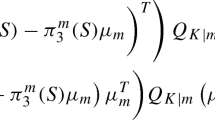Abstract
In this article we study a linear as well as a quadratic discriminant function for multi-level multivariate repeated measurement data under the assumption of multivariate normality. We assume that the m-variate observations have jointly equicorrelated covariance structure in addition to a Kronecker product structure on the mean vector. The new discriminant functions are very effective in discriminating individuals when the number of observations is very small. The proposed classification rules are demonstrated on a real data set. The error rates of the proposed classification rules are found to be much less than the error rates of the traditional classification rules, when in fact the traditional classification rules fail most of the time owing to the small sample sizes.
Similar content being viewed by others
References
Anderson TW (2003). An introduction to multivariate statistical analysis, 3rd edn. Wiley, New Jersey
Bartlett MS (1951). An inverse matrix adjustment arising in discriminant analysis. Ann Math Statist 22(1): 107–111
Choi SC (1972). Classification of multiple observed data. Biom J 14: 8–11
Gupta AK (1980). On a multivariate statistical classification model. In: Gupta, RP (eds) Multivariate statistical analysis, pp 83–93. Amsterdam, North Holland
Gupta AK (1986). On a classification rule for multiple measurements. Comput Math Appl 12A: 301–308
Johnson RA and Wichern DW (2007). Applied multivariate statistical analysis. 6th edn. Pearson Prentice Hall, New Jersey
Krzanowski WJ (1993). Antedependence models in discriminant analysis of high-dimansional spectroscopic data. In: Cuadras, CM and Rao, CR (eds) Multivariate analysis: future directions, vol. 2, pp 301–308. Elsevier, Amsterdam
Krzanowski WJ (1999). Antedependence models in the analysis of multi-group high-dimensional data. J Appl Stat 26(1): 59–67
Leiva R (2007). Linear discrimination with equicorrelated training vectors. J Multivariate Anal 98: 384–409
Leiva RA and Herrera M (1999). Generalización de la distancia de Mahalanobis para el análisis discriminante lineal en poblaciones conmatrices de covarianza desiguales. Revista de la Sociedad Argentina de Estad ística, 3: 64–85
McLachlan GJ (1992). Discriminant analysis and statistical pattern recognition. Wiley, New York
Ritter G and Gallegos M T (2002). Bayesian object identification: variants. J Multivariate Anal 81(2): 301–334
Roy A (2006). A new classification rule for incomplete doubly multivariate data using mixed effects model with performance Comparisons on the Imputed Data. Stat Med 25(10): 1715–1728
Roy A and Khattree R (2005a). On discrimination and classification with multivariate repeated measures data. J Statist Plann Inf 134(2): 462–485
Roy A and Khattree R (2005b). Classification based on multivariate repeated measures with time effect on mean vector and an AR(1) correlation structure on the repeated measures. Calcutta Stat Assoc Bull 57: 49–65
Roy A and Khattree R (2007). Classification of multivariate repeated measures data with temporal autocorrelation. J Appl Stat Sci 15(3): 283–294
Seber GAE (1984). Multivariate observations. Wiley, New York
Author information
Authors and Affiliations
Corresponding author
Rights and permissions
About this article
Cite this article
Roy, A., Leiva, R. Discrimination with jointly equicorrelated multi-level multivariate data. ADAC 1, 175–199 (2007). https://doi.org/10.1007/s11634-007-0013-0
Received:
Revised:
Accepted:
Published:
Issue Date:
DOI: https://doi.org/10.1007/s11634-007-0013-0
Keywords
- Classification rule
- Jointly equicorrelated covariance structure
- Multivariate repeated measures data
- Maximum likelihood estimates




